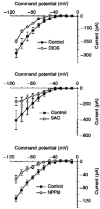Characterization of the hyperpolarization-activated chloride current in dissociated rat sympathetic neurons
- PMID: 9503329
- PMCID: PMC2230754
- DOI: 10.1111/j.1469-7793.1998.665bv.x
Characterization of the hyperpolarization-activated chloride current in dissociated rat sympathetic neurons
Abstract
1. Dissociated rat superior cervical ganglion (SCG) neurons have been shown to possess a hyperpolarization-activated inwardly rectifying chloride current. The current was not altered by changes in external potassium concentration, replacing external cations with NMDG (N-methyl-D-glucamine) or by addition of 10 mM caesium or barium ions. 2. The reversal potential of the current was altered by changing external anions. The anion selectivity of the current was Cl- > Br- > I- > cyclamate. All substituted permeant anions also blocked the current. 3. The current was blocked by DIDS (4,4'-diisothiocyanatostilbene-2,2'-disulphonic acid), 9AC (anthracene-9-carboxylic acid) and NPPB (5-nitro-2-(3-phenylpropylamino)benzoic acid) but was unaffected by SITS (4-acetamido-4'-isothiocyanatostilbene- 2,2'-disulphonic acid) and niflumic acid. The effective blockers were voltage dependent; DIDS and NPPB were more effective at depolarized potentials while 9AC was more effective at hyperpolarized potentials. 4. The current was enhanced by extracellular acidification and reduced by extracellular alkalinization. Reducing external osmolarity was without effect in conventional whole-cell recording but enhanced current amplitude in those perforated-patch recordings where little current was evident in control external solution. 5. The current in SCG neurons was blocked by external cadmium and zinc. ClC-2 chloride currents expressed in Xenopus oocytes were also sensitive to block by these divalent ions and by DIDS but the sensitivity of ClC-2 to block by cadmium ions was lower than that of the current in SCG neurons. 6. Reverse transcriptase-polymerase chain reaction (RT-PCR) experiments showed the presence of mRNA for ClC-2 in SCG neurons but not in rat cerebellar granule cells which do not possess a hyperpolarization-activated Cl- current. 7. The data suggest that ClC-2 may be functionally expressed in rat SCG neurons. This current may play a role in regulating the internal chloride concentration in these neurons and hence their response to activation of GABAA receptors.
Figures








Similar articles
-
Chloride current activated by hypotonicity in cultured human astrocytoma cells.Exp Physiol. 1995 May;80(3):373-89. doi: 10.1113/expphysiol.1995.sp003854. Exp Physiol. 1995. PMID: 7543762
-
A swelling-activated chloride current in rat sympathetic neurones.J Physiol. 1997 Jun 15;501 ( Pt 3)(Pt 3):555-64. doi: 10.1111/j.1469-7793.1997.555bm.x. J Physiol. 1997. PMID: 9218216 Free PMC article.
-
Functional and molecular characterization of a volume-sensitive chloride current in rat brain endothelial cells.J Physiol. 1999 Apr 1;516 ( Pt 1)(Pt 1):75-84. doi: 10.1111/j.1469-7793.1999.075aa.x. J Physiol. 1999. PMID: 10066924 Free PMC article.
-
Characterization of an inwardly rectifying chloride conductance expressed by cultured rat cortical astrocytes.Glia. 1997 Oct;21(2):217-27. doi: 10.1002/(sici)1098-1136(199710)21:2<217::aid-glia5>3.0.co;2-3. Glia. 1997. PMID: 9336236
-
Aspects of calcium-activated chloride currents: a neuronal perspective.Pharmacol Ther. 1995 Jun;66(3):535-65. doi: 10.1016/0163-7258(95)00018-c. Pharmacol Ther. 1995. PMID: 7494858 Review.
Cited by
-
Regulation of ClC-2 gating by intracellular ATP.Pflugers Arch. 2013 Oct;465(10):1423-37. doi: 10.1007/s00424-013-1286-0. Epub 2013 May 1. Pflugers Arch. 2013. PMID: 23632988 Free PMC article.
-
Putative ClC-2 chloride channel mediates inward rectification in Drosophila retinal photoreceptors.J Membr Biol. 2005 Oct;207(3):151-60. doi: 10.1007/s00232-005-0810-3. J Membr Biol. 2005. PMID: 16550486
-
The chloride channel ClC-2 contributes to the inwardly rectifying Cl- conductance in cultured porcine choroid plexus epithelial cells.J Physiol. 2000 Mar 1;523 Pt 2(Pt 2):313-24. doi: 10.1111/j.1469-7793.2000.t01-1-00313.x. J Physiol. 2000. PMID: 10699077 Free PMC article.
-
Extracellular zinc ion inhibits ClC-0 chloride channels by facilitating slow gating.J Gen Physiol. 1998 Dec;112(6):715-26. doi: 10.1085/jgp.112.6.715. J Gen Physiol. 1998. PMID: 9834141 Free PMC article.
-
Aberrant chloride transport contributes to anoxic/ischemic white matter injury.J Neurosci. 2003 May 1;23(9):3826-36. doi: 10.1523/JNEUROSCI.23-09-03826.2003. J Neurosci. 2003. PMID: 12736353 Free PMC article.
References
-
- Ackerman MJ, Wickman KD, Clapham DE. Hypotonicity activates a native chloride current in Xenopus oocytes. Journal of General Physiology. 1994;103:153–179. 10.1085/jgp.103.2.153. - DOI - PMC - PubMed
-
- Anderson MP, Sheppard DN, Berger HA, Welsh MJ. Chloride channels in the apical membrane of normal and cystic fibrosis airway and intestinal epithelia. American Journal of Physiology. 1992;263:L1–14. - PubMed
Publication types
MeSH terms
Substances
Grants and funding
LinkOut - more resources
Full Text Sources

